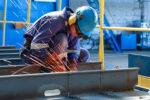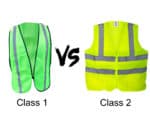Since the introduction of kevlar, it has played an important role in the global battle against violent crimes. Kevlar fabric is frequently used by police enforcement agencies all across the world.
As a result, vests that defend against these hazards are in high demand among police officers, security guards, and doormen, as well as those who are concerned about a personal assault.
The reason behind kevlar’s popularity for security reasons is because of its weight. It is protective, but also a lightweight fabric in comparison to other body armor materials.
Kevlar is not completely impenetrable. They are more knife resistant than knife proof, which means they provide some level of protection but doesn’t guarantee full safety. The Kevlar slows the blade to reduce the chances of injury, but it does not totally prevent harm.

So how does kevlar work against sharp objects?
1.) Kevlar provides you with potentially lifesaving protection that the human body lacks on its own.
Kevlar vests are resistant to penetration by pointed objects like knives and other sharp items like broken bottles. Their shape enables them to shield the body against punctures caused by sharp blades or pointed weapons.
2.) Kevlar is produced from a synthetic fiber called aramid which has a high tensile strength. It has proven to be one of the world’s toughest materials. It is also used in bulletproof and stab resistant jackets.
3.) Kevlar fabric is closely woven together to make stab resistant vests for optimum protection. While kevlar is powerful on its own, it’s protection levels are high when they are densely woven together to form a protective barrier.
Since the fibers are tightly woven together, it is incredibly difficult for a weapon to penetrate the material because you need a great deal of pressure to really pierce through the fabric.
What are the different knife protection levels of Kevlar?
Since we’re concentrating on a Kevlar vest’s capacity to stop a knife, we’ll look at the protection levels for the edged blade vest. The table below contains data as determined by the National Institute of Justice.
| Knife protection (Level 1) | Knife protection (Level 2) | |
| Energy Level | E1 | E1 |
| Energy | 24 joules | 33 joules |
| Velocity | 5 minutes per second | 5.9 minutes per second |
| Total Missile Mass | 1.9 Kg | 1.9 Kg |
| Maximum Penetration | 7 mm | 7 mm |
Watch this full video to understand the protection level offered by kevlar-
Let us understand some drawbacks with Kevlar
1.) The type of blade also determines the kevlar’s ability to protect you.
Yes, even if you’re wearing a Kevlar vest designed to guard against edged blades, you’ll still be exposed to thin, sharp tools. Screwdrivers, needles may fit through the gaps in the weave of the Kevlar vest. You will be more vulnerable to harm if the attacker uses a weapon with a narrow, sharp tip.
2.) First, the angle of the blade plays an important role.
When kevlar is tested professionally, they hardly take into account the various, different angles from which a person could be attacked and stabbed.
“National Institute of Justice (NIJ) sets the spike or stab maximum penetration depth at 7mm (0.28″) from a thrust at a 90 degree angle (perpendicular) to the protective material.”
Body Armor Guide- National Institute of Justice- https://www.ojp.gov/pdffiles1/nij/247281.pdf
This means, Kevlar is intended to reduce the pressure of a stab from a 90-degree angle, but it does not talk about how it reacts to an attack from other angles.
3.) The intensity of the force also matters on how much Kevlar can protect you.
An attack is determined by its intensity, power and purpose. If you think you cannot be injured in a knife attack wearing a Kevlar, then you’re wrong.
You can still receive injuries while wearing a Kevlar vest. You can be gravely hurt if a huge, powerful object stabs you with a lot of strength with the aim to potentially kill you.
Therefore, even when wearing a Kevlar vest, you can be harmed by a knife. The degree of the damage is determined by the above mentioned points and can range from minor bruising to death. Wearing a Kevlar vest, on the other hand, gives the maximum protection.
Here we provide you with two tips to ensure maximum safety out of your kevlar
Your Kevlar vest will not be as effective or last as long if it is not properly cared for. To maximise the usefulness and lifespan of your vest, you must understand how to care for it.
1.) Make Sure Your Kevlar Vest Fits Properly
First and foremost, ensure that your Kevlar vest fits properly. A vest that is too tight may stretch out the fibres and weaken them over time, which will eventually lessen the density and limit protection from stabbing assaults.
2.) Store your kevlar nicely
To make sure your kevlar lasts long, you really need to preserve it nicely. Remember not to hang your kevlar vest as it might cause the straps to stretch out over time and become loose. Always place it on a flat surface.
It is also important that the vest never be balled up in a washing basket, since this might cause it to become deformed and compromise the vest’s integrity and protection features.
What are the other types of protection offered by Kevlar?
1.) Protection from spikes- While you may believe that spike protection is the same as edged blade protection, this sort of Kevlar is built differently.
Objects like needles and screwdrivers, which are thinner than bullets and knives, may be able to penetrate through the Kevlar.
Spike protection vests frequently combine the bulletproof and stab-proof vests’ properties, then add an extra plastic laminate layer to eliminate the risks of small, sharp objects.
2.) Protection from bullets- This sort of Kevlar vest is usually referred to as a bulletproof vest since it is especially designed to defend against bullets. The degree of the vest defines which sorts of gunshots it can resist.
3.) Protection against edged blades and knives- Kevlar vests that are especially designed to protect against knives and blades are called stab-proof vests.
Many of these vests will also have ballistic protection, making them more effective against a wide range of weapons such as knives, axes, shattered glass, and bullets.
See also: Kevlar Vs. Carbon Fiber Hard Hat: Which One Protects Head Better?
So how do you know when it’s time to change your kevlar vest?
You know it’s time to change your kevlar vest if it has been penetrated by a knife. A kevlar vest that has been injured by a sharp item will not provide the same level of protection as a vest that has not been damaged.
While a knife can pierce the fabric of a Kevlar vest, it seldom goes all the way through. However, the fibres in the area where the damage occurred will no longer be firmly knit.
Even if you’re not aware of any incidents in which your Kevlar vest was damaged, it’s still a good practise to examine it before each usage.
The more a Kevlar vest is used, the more wear and tear it will experience. Because this will reduce the amount of protection, you may need to replace it.
Conclusion
Kevlar vests can protect you from being stabbed with a sharp object, but they are not 100% impenetrable.
Choosing the appropriate amount of protection, maintaining correct maintenance, and updating your vest as needed will give you the most benefits that Kevlar has to offer.







